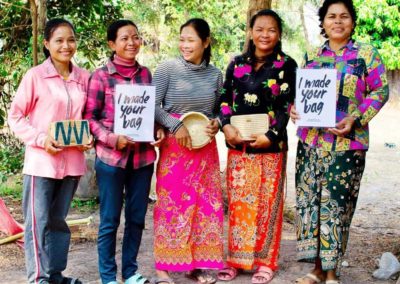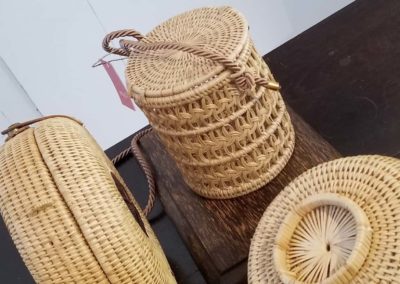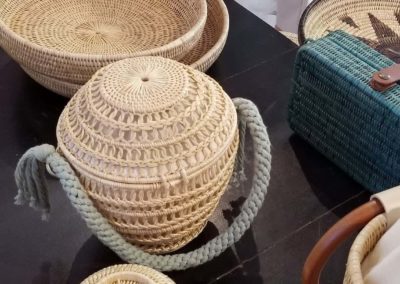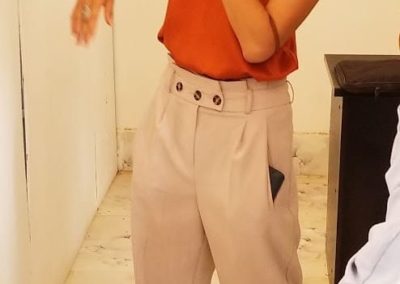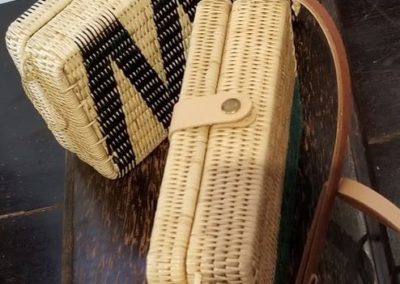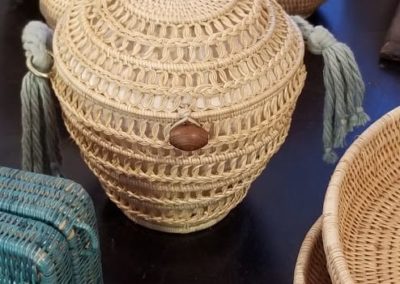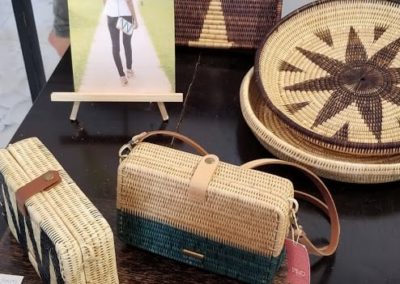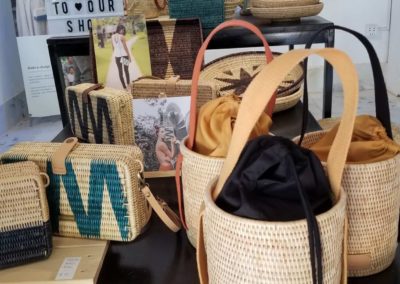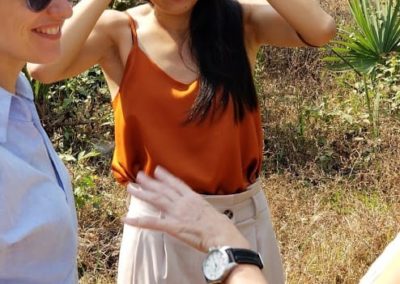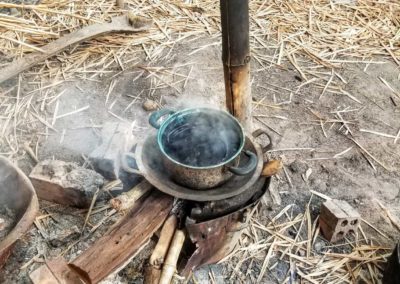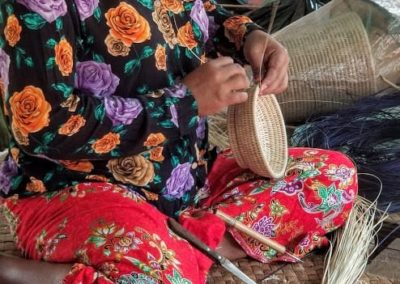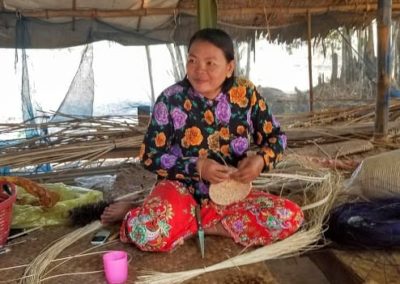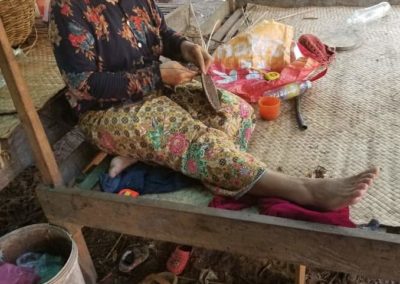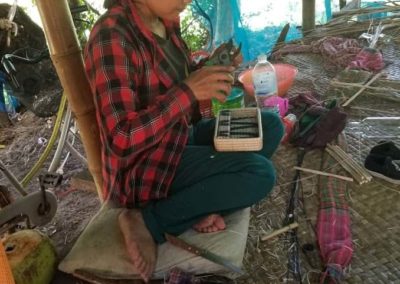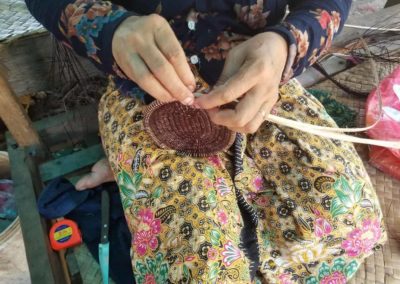Ka-Lai Chan had been on my horizon long before I moved to Cambodia. I was familiar with her home and furniture design so when I learned she had started MANAVA, a company supporting women artisans by creating artful rattan products, I set out to find her in Krobey Riel village, outside of Siem Reap. Arriving unannounced on a steaming hot afternoon, and accompanied by two young Khmer girls interested in the arts, a surprised Ka-Lai stopped her work and graciously showed us around. We met her partner, Baraing Tho, and chatted with several of the weavers as we watched them work. Despite interrupting their work day, we were generously educated about the weaving process, the plants and the mission of the business. And the products? Baskets, hand bags, platters, and bowls – all stunning in their simplicity and design that celebrates Khmer culture. I left that first visit to MANAVA feeling that regardless of the difficulties ahead, MANAVA was going to thrive, inspire, and contribute in countless ways to the Land of Wonder. I also left knowing that Ka-Lai Chan was a remarkable and quietly powerful force.
There is a pleasant and peculiar characteristic of living in Cambodia: people meet each other and are accepted at face value. Seldom are you asked what you have accomplished in your life or what you have done in the past? You are here, now, and relationships grow from a fresh perspective. So Ka-Lai Chan didn’t inquire about my curiosity for her work and I didn’t need to explain my personal background to her. It’s all rather refreshing.
Nonetheless, I was aware of Ms. Chan’s credentials and her previous work had impressed me. How did this European trained designer come to Cambodia to work with female weavers in a tiny village?
Ka-Lai Chan graduated from the University of Arts in Utrecht and proceeded to work as an independent designer for international design brands, museums, art installations, and hotels. Her designs are clean, simple and reflective of her inner life. Viewing these earlier designs reveals how and why her MANAVA products are so striking and reflective about Khmer culture and the landscape of Cambodia.

Ka-Lai Chan – Selfportrait
Fotografie: Marion Panhuijzen
“In the past, I have always found myself to be a quiet and introvert person. I suppressed my own emotions and didn’t dare to show my feelings to other people. I was afraid that people will find me weird for being who I am. It felt like there was something growing on me which gets bigger and bigger like a tumor. I always tend to hide away my personality, but on the other hand I wanted nothing more but to open up and just be myself.”
The round and swollen parts of the chair design ‘Selfportrait’ represent the suppressed emotions, which reflects a certain tension. The holes in the skin are created by the inside (me) that wants to come out. It pushes the skin open. The real personality of me and my emotions which want to reveal itself to the outside world.”
Quote from an article on Dezeen.






“The Ordinary Family” (2012). A furniture collection partly inspired by stories of the designer’s own family or observations of families around her. Every family, however ordinary has their own secrets and taboos. Photo credits: Jay Tang | VISUAL CREATURE

Dutch designer Ka-Lai Chan has wrapped a whole wall, furniture and ornaments behind an all-encompassing layer of sticky tape at an abandoned apartment in Utrecht. 2012
The installation was one of ten created earlier this year by artists and designers in a building set to be demolished to make way for a new housing development.
She claims her inspiration for the project was the way people “adapt to society” by trying to fit in, but also want to reveal their own identities.
The tape makes everything the same,” Chan told Dezeen. “Object and wall are merged and belong together, but the objects are also rising out of the wall and want to stand out.” – From PLAY Project by Ka-Lai Chan, Amy Frearson |
Ka-Lai Chan, born in 1985. “With my creations”, says Ka-Lai “I want to reveal the hidden value of everyday objects and materials, allowing people to see the beauty of things and experiment them in an unusual way.”
After a chance encounter found her traveling to Cambodia as a volunteer, Ka-Lai Chan fell in love with the countries traditional craft, and her research took her to the rural countryside. On a visit to Krobey Riel village, situated about an hour outside Siem Reap, she became fascinated by the skill set of the local women who were able to weave beautiful, functional products from natural fibres. She also saw, however, that despite their talents they couldn’t earn enough to support their families.
Inspired by her design background and the women’s weaving talent, Ka-Lai launched MANAVA in 2016, a conscious accessory and homeware label. Her mission? To share artisanal Cambodian craft with the world, while improving the lives and income of this little community.
MANAVA now employs and provides fair income to 15 artisans who hand craft the labels bag and homeware products. Since joining MANAVA, their income and family contribution has increased by 75%! We chatted with Ka-Lai all about her journey to create such a meaningful social enterprise.
You’re a natural creative. What’s your background?
I completed a product design degree from the University of Arts in Utretcht, The Netherlands. Since 2009, I’ve been working as an independent designer for several international designer brands, museums and hotels designing home products and art installations.
So how did you end up in Cambodia?
There are three things that are really important to me: nature, people and creation. These three things give me energy and give life meaning. Even before visiting Cambodia, I had a deep desire to help people in a less developed country and to connect them with creativity and the arts.
By chance, I met a young lady in The Netherlands who was conducting a project in Cambodia, and I took the opportunity to volunteer for two months with her. For me, It felt like the beginning of a dream come true. The Kingdom of Cambodia is incredible. The people are genuine, cheerful and relaxed. The landscape, in particular the countryside and rice fields, are simply magical. Life here is simple and the crafts are stunning.
“The Kingdom of Cambodia is incredible. The people are genuine, cheerful and relaxed. The landscape, in particular the countryside and rice fields, are simply magical.”
How did the inspiration for MANAVA come about?
While volunteering in Siem Reap, I did a lot of research on different local traditional crafts and spent time with families in the countryside. This was such an enriching experience; they were always happy and always laughing. But behind the smiles, I could see they were struggling with many challenges, the most obvious of which was their income level. They earned an average of $50 to $70 per month, which made it almost impossible for them to live within their means, yet many had such incredible weaving skills, particularly in one village I visited, Krobey Riel.
With my entrepreneurial and creative background, I saw possibilities to help them. I then met Baraing Tho, a local creative young man with the same vision and together we decided to start MANAVA.
There’s quite a process involved in creating each product. First, we harvest the rattan from local forests using a sustainable strategy. Then we leave the rattan stalks to dry, which can take up to a month till they’re just right. Then, we clean it and peel off the outer fibre. We discovered a creative way to do this using a beer bottle cap with a pierced hole, which separates the inner and outer fibres in one sweeping motion! After that, we dye the willow with natural powders derived from plants and flowers. The final step is to hand weave the bag or basket with careful attention and experienced skill, which can take up to three days per bag.
Cambodia is well-known for it’s fast fashion factories. Why does being a socially conscious enterprise matter to you?
It matters because people matter to me. The women and families that we work with are people just like you and me, naturally kind-hearted and pure. I truly respect and admire the integrity they have for their work, and their traditional crafts are just remarkable.
Naturally, I believe they deserve a fair income, should be treated well and have the opportunities to achieve certain life skills. As a business owner, I want to encourage an environment where their opinion matters and provide them the opportunity to improve their quality of life through their indigenous skills sets.
Why should the world care about preserving artisanal craft?
In today’s day and age where mass production and speedy consumption is the norm, we can acquire things faster and at a cheaper price but attention to quality has taken a back seat. By and large, I think we’ve grown to neglect what’s important and meaningful, and have less emotional connection to our possessions. Artisan craft helps us reignite that connection through the stories of where they’ve come from and how they’re made. This is what I want to share with the world through MANAVA.
Finally – what’s been your biggest learning lesson so far?
In a country like Cambodia, very little goes as planned. I think the biggest thing I’ve learned on this journey is patience!
Translated from Sanskrit, MANAVA means humankind. MANAVA believes in love, people and culture being at the heart of all our designs. We are here to support female artisans by creating exclusive, artisanal rattan products that strengthen the international reputation of Cambodia’s creative industries. Bringing people together to preserve an important part of Cambodia’s cultural legacy, while also providing education and empowerment training to Cambodian women.


Please explore MANAVA’s website and Facebook page for gorgeous product photos and thoughtful words about their enterprise, hopes, and process. They are doing it right.






